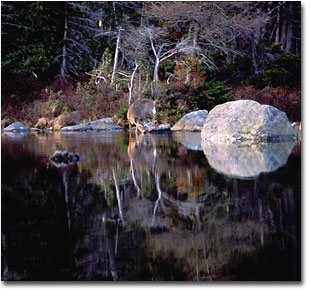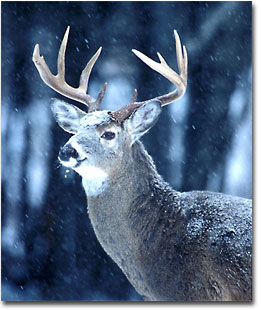My wife says that Iím not a patient man.
She claims she has proof. She says that the guy who gets mad at the dumb driver ahead who holds him from getting through the green light, or who starts pacing when sheís a tad late getting ready to go out to meet friends for dinner, or who sometimes canít wait for the first cup of coffee and pulls the carafe from the coffee maker and shoves a cup in there instead couldnít possibly be considered patient.
So she wants to know: how can I sit some place in the woods all day just waiting for the right deer or moose or bear to come along to pose for the camera?
Does any of this sound vaguely familiar?
 Woods Patience
Woods Patience
Patience comes in many forms. I suspect it also comes with special strings attached. Those strings stem from the things that one finds of importance, or at least, of interest.
For example, Iíll bet that some of those who donít mind standing in line for an hour to get into a popular restaurant in a city would get bored if they had to wait for more than fifteen minutes waiting for a deer to show up along some forest edge at dusk.
I know folks who can spend an entire day shopping at a mall and come back with nothing and still tell you that they had a good time. Does that work for you? Me neither. But I can hang around a wilderness pond all day, watch the birds, listen to the sound of the wind and the lap of the water on the shore, smell the spruce and fir and pine in the air, and not get impatient waiting to see a moose. Yet I know that some of the people who have such patience at things that seem such a waste of time to me would get horribly bored after a half hour of waiting in such a setting. Why do you suppose that is? I think itís because patience comes in many forms.
My form is woods patience. Whatís yours?
Patient Observations
Those who have woods patience know how to make the most of their time in the outdoors. While Iím sitting in the woods waiting for a photographic target, Iím observing and learning from what goes on around me. The songs that different birds make, the way the wind affects their flight, their direction of travel - these things hold my interest while I wait. They keep me amused. Knowing such things might also come in handy in the future.
Other observations while waiting help me to bring back the trophy images that Iím always on the lookout for. One of those observations is the different backgrounds that a place offers the camera hunter. Backgrounds can make or break a photograph. The wrong background, such as one cluttered with tree stumps and snags, can distract the viewerís eye so much that it ruins a photograph. The right background, such as one filled with fall colors, can make the photograph so distinct from the typical image of a moose or a deer or a bear that it transcends it into more than just a picture of an animal.
 Those truly great backgrounds are usually the most difficult to place an animal in. Sometimes, Iíll wait all day watching the right background at a place that wildlife frequent.
Those truly great backgrounds are usually the most difficult to place an animal in. Sometimes, Iíll wait all day watching the right background at a place that wildlife frequent.
More often than not the camera hunter has to be satisfied with a good, ďcleanĒ background. Whatís a clean background? One thatís simple enough that it allows the subject to dominate the photograph without anything to cause a distraction. It might also have some good color to it, perhaps the blue of the lake or the green of a distant tree line. Or it might just be a simple setting thatís out of focus because of the limited depth of field of the camera hunterís long telephoto lens.
Not the least of the observations, I always make while waiting, and one that all serious camera hunters should watch for, is the way that the light works against the different backgrounds of a place throughout the day. An observant camera hunter can gain much knowledge of when to be where for another day by paying careful attention to the play of light on the forest or the distant hills or the lake surface in front of him or her.
Light makes magic for the camera hunter. Oh sure, you need a good target at a decent range with a clean background, but all of those things donít matter much if you donít have the right light. Good light makes good photos. And great light makes great photos.
When Everything Works
The best days for camera hunters occur when everything works. The background lights up with great light just as the target animal steps into the scene! Does that happen often? No, but when it does, the smart camera hunter realizes the value of all that woods patience and usually, he will run lots of film through the camera.
And if nothing at all happens? Then be sure to learn while youíre waiting. Pay careful attention to the way the light plays before you and how the backgrounds work and what the animals that you do see behave. You just never know how any of this information will pay off when everything comes together in that one special moment.
Catch yours in the good light.
BS-NPN 012
http://camerahunter.com
Comments on Bill Silliker, Jr.'s The Camera Hunter articles? Send them to the editor.
Maine wildlife & nature photographer Bill Silliker, Jr. Ė The Mooseman - photographed at many wild places in North America, with the results published in magazines internationally and in 9 of his own books. Bill was an instructor of wildlife and nature photography for L. L. Bean's Outdoor Discovery Program and a member of the Fuji Film Talent Team. Read more about Bill on the Camera Hunter archives page.



